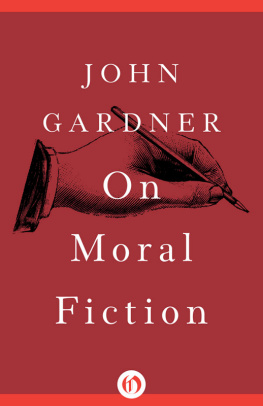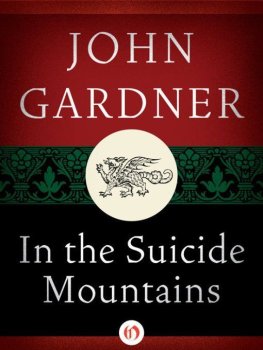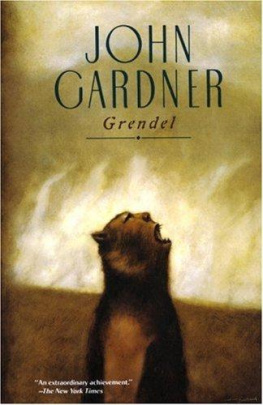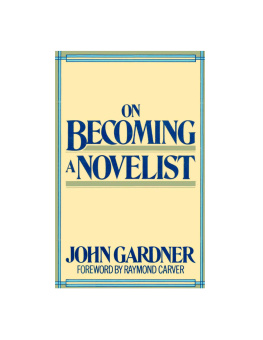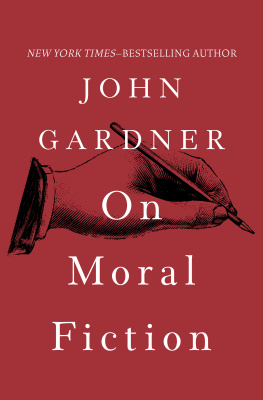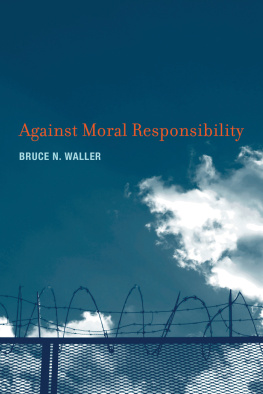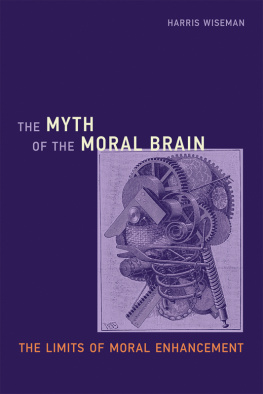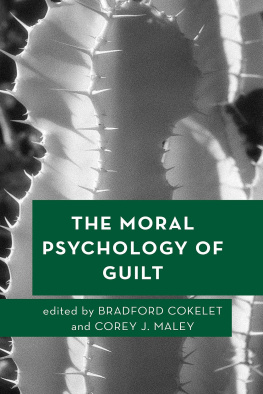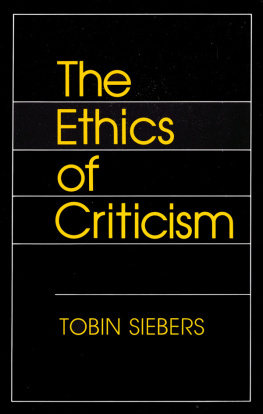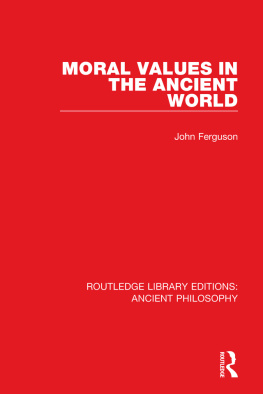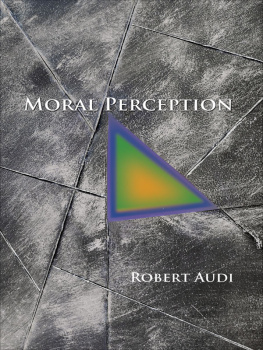John Gardner - On Moral Fiction
Here you can read online John Gardner - On Moral Fiction full text of the book (entire story) in english for free. Download pdf and epub, get meaning, cover and reviews about this ebook. year: 1979, publisher: Basic Books, Inc., genre: Science. Description of the work, (preface) as well as reviews are available. Best literature library LitArk.com created for fans of good reading and offers a wide selection of genres:
Romance novel
Science fiction
Adventure
Detective
Science
History
Home and family
Prose
Art
Politics
Computer
Non-fiction
Religion
Business
Children
Humor
Choose a favorite category and find really read worthwhile books. Enjoy immersion in the world of imagination, feel the emotions of the characters or learn something new for yourself, make an fascinating discovery.
- Book:On Moral Fiction
- Author:
- Publisher:Basic Books, Inc.
- Genre:
- Year:1979
- Rating:5 / 5
- Favourites:Add to favourites
- Your mark:
- 100
- 1
- 2
- 3
- 4
- 5
On Moral Fiction: summary, description and annotation
We offer to read an annotation, description, summary or preface (depends on what the author of the book "On Moral Fiction" wrote himself). If you haven't found the necessary information about the book — write in the comments, we will try to find it.
On Moral Fiction — read online for free the complete book (whole text) full work
Below is the text of the book, divided by pages. System saving the place of the last page read, allows you to conveniently read the book "On Moral Fiction" online for free, without having to search again every time where you left off. Put a bookmark, and you can go to the page where you finished reading at any time.
Font size:
Interval:
Bookmark:


For Liz
PREMISES ON ART AND MORALITY
A BOOK AS WIDE-RANGING as this one needs a governing metaphor to give it at least an illusion that all is well:
It was said in the old days that every year Thor made a circle around Middle-earth, beating back the enemies of order. Thor got older every year, and the circle occupied by gods and men grew smaller. The wisdom god, Woden, went out to the king of the trolls, got him in an armlock, and demanded to know of him how order might triumph over chaos.
Give me your left eye, said the king of the trolls, and Ill tell you.
Without hesitation, Woden gave up his left eye. Now tell me.
The troll said, The secret is, Watch with both eyes!
Wodens left eye was the last sure hope of gods and men in their kingdom of light surrounded on all sides by darkness. All we have left is Thors hammer, which represents not brute force but art, or, counting both hammerheads, art and criticism. Thor is no help. Like other gods, he has withdrawn from our immediate view. We have only his weapon, abandoned beside a fencepost in high weeds, if we can figure out how to use it. This book is an attempt to develop a set of instructions, an analysis of what has gone wrong in recent years with the various artsespecially fiction, since that is the art on which Im best informedand what has gone wrong with criticism.
The language of critics, and of artists of the kind who pay attention to critics, has become exceedingly odd: not talk about feelings or intellectual affirmationsnot talk about moving and surprising twists of plot or wonderful characters and ideasbut sentences full of large words like hermaneutic, heuristic, structuralism, formalism, or opaque language, and full of fine distinctionsfor instance those between modernist and post-modernistthat would make even an intelligent cow suspicious. Though more difficult than ever before to read, criticism has become trivial.
The trivial has its place, its entertainment value. I can think of no good reason that some people should not specialize in the behavior of the left-side hairs on an elephants trunk. Even at its best, its most deadly serious, criticism, like art, is partly a game, as all good critics know. My objection is not to the game but to the fact that contemporary critics have for the most part lost track of the point of their game, just as artists, by and large, have lost track of the point of theirs. Fiddling with the hairs on an elephants nose is indecent when the elephant happens to be standing on the baby.
At least in America art is not thought capable, these days, of tromping on babies. Yet it does so all the time, and what is worse, it does so with a bland smile. Ive watched writers, composers, and painters knocking off their works with their left hands. Nice people, most of them. Artists are generally pleasant people, childlike both in love and hate, intending no harm when they turn out bad paintings, compositions, or books. Indeed, their ambition guarantees that they will do the best they know how to do or think they ought to do. The error is less in their objects than in their objectives. Art is play, or partly play, theyll tell you with an engaging smile, serving up their non-nutritious fare with the murderous indifference of a fat girl serving up hamburgers. What they say is true enough, as far as it goes, and nothing is more tiresome than the man who keeps hollering, Hey, lets be serious! but that is what we must holler.
In a world where nearly everything that passes for art is tinny and commercial and often, in addition, hollow and academic, I argueby reason and by banging the tablefor an old-fashioned view of what art is and does and what the fundamental business of critics ought therefore to be. Not that I want joy taken out of the arts; but even frothy entertainment is not harmed by a touch of moral responsibility, at least an evasion of too fashionable simplifications. My basic message throughout this book is as old as the hills, drawn from Homer, Plato, Aristotle, Dante, and the rest, and standard in Western civilization down through the eighteenth century; one would think all critics and artists should be thoroughly familiar with it, and perhaps many are. But my experience is that in university lecture halls, or in kitchens at midnight, after parties, the traditional view of art strikes most people as strange news.
The traditional view is that true art is moral: it seeks to improve life, not debase it. It seeks to hold off, at least for a while, the twilight of the gods and us. I do not deny that art, like criticism, may legitimately celebrate the trifling. It may joke, or mock, or while away the time. But trivial art has no meaning or value except in the shadow of more serious art, the kind of art that beats back the monsters and, if you will, makes the world safe for triviality. That art which tends toward destruction, the art of nihilists, cynics, and merdistes, is not properly art at all. Art is essentially serious and beneficial, a game played against chaos and death, against entropy. It is a tragic game, for those who have the wit to take it seriously, because our side must lose; a comic gameor so a troll might saybecause only a clown with sawdust brains would take our side and eagerly join in.
Like legitimate art, legitimate criticism is a tragicomic holding action against entropy. Life is all conjunctions, one damn thing after another, cows and wars and chewing gum and mountains; artthe best, most important artis all subordination: guilt because of sin because of pain. (All the arts treat subordination; literature is merely the most explicit about what leads to what.) Art builds temporary walls against lifes leveling force, the ruin of what is splendidly unnatural in us, consciousness, the state in which not all atoms are equal. In corpses, entropy has won; the brain and the toenails have equal say. Art asserts and reasserts those values which hold off dissolution, struggling to keep the mind intact and preserve the city, the minds safe preserve. Art rediscovers, generation by generation, what is necessary to humanness. Criticism restates and clarifies, reenforces the wall. Neither the artist nor the critic believes, when he stands back from his work, that he will hold off the death of consciousness forever; and to the extent that each laughs at his feeble construction he knows that hes involved in a game. As long as he keeps the whole picture in mindthe virtues and hairline cracks in the wall, the enormous power of the turbulence outsidethe artist and after him the critic can do what he does with reasonable efficiency. The moment the artistic or critical mind loses sight of the whole, focusing all attention on, say, the flexibility of the trowel, the project begins to fail, the wall begins to crack with undue rapidity (we expected all along that the wall would crack, but not like this! not there and there too and even there!) and the builder becomes panicky, ferocious, increasingly inefficient.
Next pageFont size:
Interval:
Bookmark:
Similar books «On Moral Fiction»
Look at similar books to On Moral Fiction. We have selected literature similar in name and meaning in the hope of providing readers with more options to find new, interesting, not yet read works.
Discussion, reviews of the book On Moral Fiction and just readers' own opinions. Leave your comments, write what you think about the work, its meaning or the main characters. Specify what exactly you liked and what you didn't like, and why you think so.

